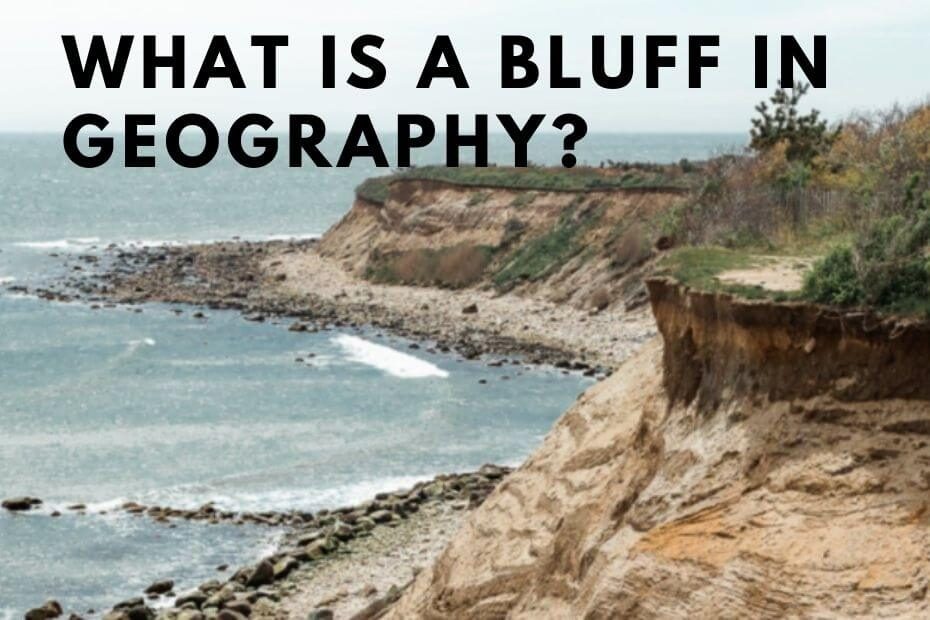What Is A Bluff In Geography? Bluff is a term that has been used since the early days of geography. The term can refer to a hill, rock, or other types of high ground that is prominent enough to be seen from a distance.
Bluffs are important because they are dominant features in visual landscapes and they are significant for their potential to be used as landmarks for navigation.
The presence of bluffs also affects how rivers flow through their landscape which influences many aspects of geology and water management.
What Is A Bluff In Geography?
A bluff is a ridge of land that extends into the air. The term is commonly used in geography to refer to high ground. Bluffs are often situated at the foot of steep cliffs and mountains.
A bluff is a steep hill or cliff, especially one that appears close to its base. It can also refer to an area where the slope is so steep that it appears to be an unbroken cliff.
A typical bluff is situated at the foot of steep cliffs and mountains.
Why Is A Bluff Called A Bluff?
A bluff is a cliff, small hill, or other elevation on the side of a mountain or hill, that rises steeply from the ground, usually without trees or shrubs.
Bluffs are called bluff because they appear to be higher than they actually are. From the distance, they seem to be steeper than they actually are.
How Is A Bluff Formed?
How a bluff is formed in geography is a question that has no clear answer. It all depends on the environment that the bluff was formed in and other factors like how deep it is and how much erosion takes place.
When a bluff is created naturally, it forms by the force of wind and water along with the effect of gravity on the earth’s surface. This natural process mainly happens in steep places where there are high elevation changes.
As the slope becomes too steep for the water or wind to erode it, it builds up and forms a bluff.
Bluffs are also formed by the slow movement of glaciers, ice sheets, and permafrost. Glaciers push large amounts of rock off of mountainside through grinding and crushing – this produces large boulders that act as rubble dams blocking the flow of streams.
How To Identify A Bluff In Geography?
Bluffs are natural formations that can be found near water and mountain ranges. They take many forms and typically look like a hill reaching the sky or a mound of rock.
There are many ways to identify a bluff. A bluff is usually steep enough to have a significant decline or incline on both sides of the top.
The bluffs are not just steep but have uneven, sharp sawtooth edges that provide cover for any assailant. The bluff is also made up of large stones that have become cemented together over time and are covered with moss and vegetation, which further provides cover from above.
Bluff is not higher than its surroundings but it grants an advantage to those who use it as cover from above due to the uneven, sharp edges.
Bluffs are also characterized by their lack of vegetation and the presence of large rock formations jutting out from them.
In order to identify a bluff, you need to look at the shape and size. The bluffs should be steep, irregularly shaped.
What Is A Bluff On A Lake Or Beach?
A bluff is a shoreline that plunges abruptly into the water, as seen in some lakes and rivers. In order to prevent erosion from the water, the land behind a bluff is often protected by planting shrubs and trees along the steep slope of the bank.
A bluff can be created naturally or artificially through human efforts such as earth-moving projects, filling of river beds, building dams, or installing rock protections.
Cliff vs Bluff [What Is A Bluff In Geography]
Here are some of the differences between a bluff and a cliff:
Cliff
A cliff is a sharp change in elevation with little or no horizontal level between two points of different elevations. A cliff face is usually vertical or nearly so but can also be almost flat at low elevations.
Such features are typically found in mountainous terrain and may be formed either by erosion or by other types of geological activity.
Cliffs can be considered natural features that stabilize a slope, preventing further erosion and landslides from occurring on the mountainside, but they have also been used for building retaining walls and even as places to live.
Bluff
A bluff is a high point of land that appears to be very steep, but it is actually not.
Bluffs are generally found on the side of a mountain or hill, but sometimes they are found on level ground or even on the seashore.
Bluffs are defined by their steepness, meaning the difference in elevation between the highest point on top of the bluff and its base.
Conclusion: What Is A Bluff In Geography
When you are talking about geography, bluff can be a natural feature, a geological formation, or an archaeological site. These things that are difficult to see from one perspective are easy to spot from another perspective.
Bluff is the name given to a low-lying area of land that is surrounded by steep cliffs, steep slopes, or water. It’s the place you hide in when you don’t want to be seen.
